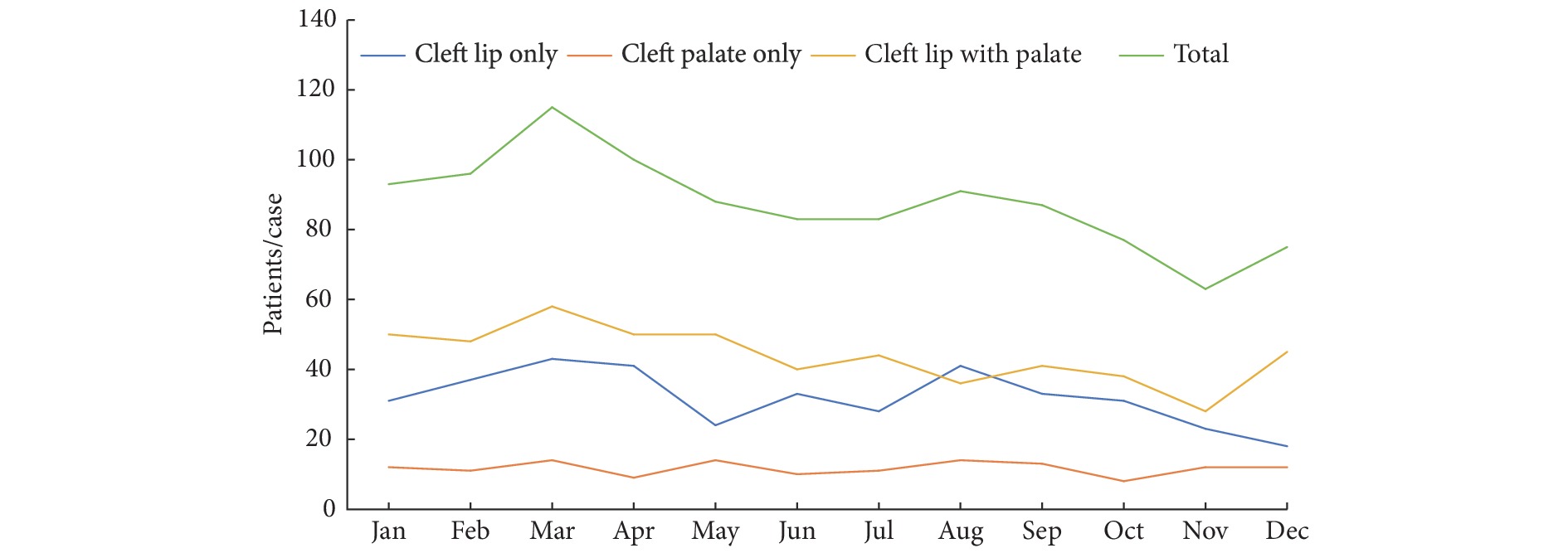Clinical Characteristics Analysis of 1051 Cases of Cleft Lip With/Without Cleft Palate in the Ethnic Tibetan Population
-
摘要:目的
了解藏族人群先天性唇腭裂的临床流行特征,为开展藏族人群唇腭裂精准防治提供依据。
方法收集2016年1月−2023年8月间,四川大学华西口腔医院收治的2月龄~51岁藏族唇腭裂患者(以四川省以及西藏自治区为主要来源)临床资料,分析其临床特征。
结果本研究共纳入
1051 例患者,以小于12月龄患儿为主(460例),其中单纯唇裂383例(36.44%),单纯腭裂140例(13.32%),唇裂伴腭裂528 例(50.24%)。单纯唇裂(0.99∶1)、单纯腭裂(0.54∶1)以及唇裂伴腭裂患者(1.67∶1)男女性别比的差异有统计学意义(P<0.001),但按单双侧分组,在单纯唇裂、唇裂伴腭裂这两组中性别差异均无统计学意义。双侧唇裂患者中以女性为主,单侧唇裂以及单、双侧唇裂伴腭裂均以男性为主,单侧唇裂伴或不伴腭裂均以左侧为主。综合征型唇腭裂所占总病例数的比例为3.43%,伴发畸形中最常见的是先天性心脏病;3.81%(40例)的患者有家族史,在单纯唇裂及单纯腭裂患者中,对应亲代中存在相应表型的比例高于唇腭裂其他表型。出生于春季的患儿最多(311例,29.59%),冬季的患儿最少(231例,21.98%)。结论藏族唇腭裂患者发病以唇裂伴腭裂为主,单侧唇裂伴或不伴腭裂中以左侧为主。唇部疾病表型可能具有更强的遗传性。
Abstract:ObjectiveTo examine the characteristics of the prevalence of congenital cleft lip with/without cleft palate in the ethnic Tibetan population and to provide support for the precise prevention and treatment of cleft lip with/without cleft palate in the Tibetan population.
MethodsThe clinical data of Tibetan patients with cleft lip with/without cleft palate were collected and the clinical characteristics of the patients were analyzed. The patients' age ranged from 2 months to 51 years old. All the subjects were admitted to West China Stomatology Hospital, Sichuan University for the treatment of cleft lip with/without cleft palate between January 2016 and August 2023. Most of the subjects came from Sichuan Province and the Tibet Autonomous Region.
ResultsA total of
1051 patients were enrolled and children aged under 12 months (460 cases) accounted for the largest proportion. Among the subjects, 383 had cleft lip only (36.44%), 140 had cleft palate only (13.32%), and 528 had cleft lip with cleft palate (50.24%). The male-to-female ratios of patients with cleft lip only (0.99∶1), cleft palate only (0.54∶1), and cleft lip with cleft palate (1.67∶1) exhibited significant differences (P<0.001). However, there was no significant difference in the male-to-female ratio in patients with cleft lip only or those with cleft lip with cleft palate when the subjects were divided into two groups according to whether they had unilateral or bilateral cleft lip with/without cleft palate. Most of the patients with bilateral cleft lip were female, while most of the patients with unilateral cleft lip and unilateral or bilateral cleft lip with cleft palate were male. The unilateral cleft lip with/without cleft palate was located predominantly on the left side. Syndromic cleft lip with/without cleft palate accounted for 3.43% of all the cases and the most common concomitant deformity was congenital heart disease. 3.81% (40 cases) of the patients had a family history. In the patients with cleft lip only and those with cleft palate only, the proportion of patients having parents with corresponding phenotypes was higher than those of other phenotypes of cleft lip with/without cleft palate. Regarding the birth time distribution of the children with cleft lip with/without cleft palate, Spring saw the highest number of births of these children (311 cases, 29.59%), while Winter saw the lowest number of births (231 cases, 21.98%).ConclusionThe cases of cleft lip with/without cleft palate in the ethnic Tibetan population are predominantly cleft lip and palate. Unilateral cleft lip only or cleft lip with palate is predominantly located on the left side. Lip disease phenotypes may be more heritable.
-
Keywords:
- Cleft lip /
- Cleft palate /
- Cleft lip with palate /
- Tibetan population /
- Clinical data analysis
-
唇腭裂是由于胚胎发育早期面突融合障碍导致的一类先天畸形,是新生儿最常出现的出生缺陷之一[1]。研究发现唇腭裂的发生率存在明显的种族、地域差异,在亚洲及印第安人群中的发生率明显高于欧洲裔及非洲裔人群[2]。我国唇腭裂的发生率约为1.38‰~1.67‰,其中西部地区的发生率高达1.97‰~2.19‰[3-5]。而西部地区由于民族众多,整体医疗及经济较东中部落后,在很多地区唇腭裂依然是新生儿主要的出生缺陷之一,甚至位列出生缺陷发生前列[6-7]。藏族是我国人口较多的民族,聚居地基本处于高海拔地区,其生存环境及种族来源与汉族存在差异[8],但目前缺少对藏族人群唇腭裂的流行病学调查,也鲜有针对藏族唇腭裂患者的临床资料分析[9],开展唇腭裂精准防控仍缺乏理论依据。既往针对唇腭裂的调查研究主要集中于汉族人群或以汉族人群为主[10-11],包括基于“微笑列车”基金会的数据分析[12-13]。唇腭裂的治疗周期较长,花费大,对于少数民族地区的患者家庭是一个沉重的经济负担,降低包括唇腭裂畸形在内的出生缺陷发生率,不仅能提高人口素质,也能减轻当地居民的医疗负担。为进一步了解藏族人群唇腭裂的发生及分布特征,明确唇腭裂畸形的种族特异性,本研究分析总结四川大学华西口腔医院收治的
1051 例藏族唇腭裂患者临床特征,报道如下。1. 材料与方法
1.1 研究对象
以2016年1月−2023年8月就诊于四川大学华西口腔医院的
1051 例藏族唇腭裂患者作为研究对象,入院年龄2月龄~51岁,平均年龄6.5岁。纳入标准:患者临床诊断为先天性唇腭裂;患者登记民族为藏族。排除标准:患者入院后退出,导致信息不全。1.2 研究内容
所有患儿入院时由其双亲签署知情同意书,已成年患者由本人签署知情同意书,四川大学华西口腔医院口腔颌面外科医师对其进行体格检查以及病史采集。调查及记录内容包括患者姓名、性别、年龄、出生日期、居住地址、诊断、既往治疗史和家族遗传史等。本研究通过四川大学华西口腔医院伦理委员会批准,批准号WCHSIRB-D-2016-281R1。
1.3 唇腭裂类型分类
唇腭裂依据裂隙累及的解剖部位,可将其分为单纯唇裂(cleft lip only)、单纯腭裂(cleft palate only)以及唇裂伴腭裂(cleft lip with palate)。其中单纯唇裂仅累及唇部解剖结构,可表现出左侧、右侧及双侧;单纯腭裂累及腭部解剖结构,其严重程度可以表现出从切牙孔至悬雍垂不同程度的裂开;唇裂伴腭裂则累及唇部和腭部,部分完全性腭裂与唇裂同时发生,裂隙在前颌骨部分,斜向侧方,与同侧牙槽嵴裂和唇裂相接。
1.4 统计学方法
使用SPSS 22.0软件进行统计分析,组间比较采用Fisher确切概率法,相关分析采用Kendall's tau-b法, Bonferroni多重校正的P=0.05/3=0.017,以P<0.017为差异有统计学意义。
2. 结果
2.1 唇腭裂的类型及构成比
本研究共纳入
1051 例患者,其中单纯唇裂383例(36.44%),单纯腭裂140例(13.32%),唇裂伴腭裂528 例(50.24%),见表1。表 1 唇腭裂类型及构成比Table 1. The phenotypes of cleft lip with/without cleft palate and corresponding constituent ratiosCharacteristic Cleft lip only Cleft palate only Cleft lip with palate Total Left Right Bilateral Left Right Bilateral Patients/case 207 137 39 140 250 133 145 1051 Constituent ratio/% 19.70 13.04 3.71 13.32 23.79 12.65 13.80 100.00 2.2 唇腭裂患者的性别分布
单纯唇裂、单纯腭裂以及唇裂伴腭裂患者男女性别间差异有统计学意义(χ2=38.341,P<0.001),但按照单双侧分组,在单纯唇裂、唇裂伴腭裂这两组中性别差异均无统计学意义,见表2。
表 2 各类型唇腭裂患者的性别比(n=1051 )Table 2. The sex distribution of patients with cleft lip with/without cleft palate (n=1051 )Phenotype Male/case Female/case Male∶female χ2 P Cleft palate only 49 91 0.54∶1 Cleft lip only 191 192 0.99∶1 Unilateral cleft lip 174 170 1.02∶1 0.685 0.500 Bilateral cleft lip 17 22 0.77∶1 Cleft lip with palate 330 198 1.67∶1 Unilateral cleft lip with palate 236 147 1.61∶1 0.462 0.546 Bilateral cleft lip with palate 94 51 1.84∶1 2.3 单侧裂隙部位分布
将单侧唇腭裂患者按裂隙部位进行比较,单侧唇裂左右之比为1.52∶1,单侧唇裂伴腭裂左右之比为1.87∶1,这两类患者左右之比差异无统计学意义(χ2=2.019,P=0.167),均表现出左侧多于右侧。
2.4 伴发畸形
研究发现综合征型唇腭裂共36例,占3.43%,其中单纯唇裂11例,单纯腭裂9例,唇裂伴腭裂16例,见表3。综合征型唇腭裂伴发畸形种类分布中合并先天性心脏病患者17例,合并神经系统疾病4例,合并牙数目异常4例,合并头颈部血管瘤2例,合并耳畸形2例,合并短指/趾畸形2例,合并上唇赘生物、上唇系带附着异常、舌系带过短、下唇瘘、眼部畸形、腹股沟疝、脐疝各1例。其中有3例患者合并了多个部位的畸形(除唇腭裂外还累及眼部、心脏、四肢、消化道等部位)。
表 3 综合征型唇腭裂比例分布Table 3. The distribution of syndromic cleft lip with/without cleft palateCharacteristic Cleft lip
onlyCleft palate
onlyCleft lip
with palateTotal Non-syndromic/case (%) 372 (97.13) 131 (93.57) 512 (96.97) 1015 (96.57)Syndromic/case (%) 11 (2.87) 9 (6.43) 16 (3.03) 36 (3.43) 2.5 地区分布
本研究所纳入的藏族患者,来自四川省(583例)、西藏自治区(363例)、青海省(89例)、甘肃省(14例)、新疆维吾尔自治区(1例)、云南省(1例),其中来自四川省的患者最多,占55.47%。以市/州为单位进行分析,四川省患者数以甘孜藏族自治州患者最多,有387例(66.38%),其次为阿坝藏族自治州156例(26.76%),成都市20例(3.43%);西藏自治区患者中昌都市患者最多,有141例(38.84%),拉萨市81例(22.31%),那曲市80例(22.04%);青海省患者主要来自于果洛、玉树、海南藏族自治州等藏族聚居地。
2.6 年龄分布
以患者首次入院登记年龄进行统计,本研究所纳入患者年龄为2月龄至51岁,平均年龄为6.5岁,其中2~12月龄(含)患儿有460例,12月龄~3岁(含)有195例,3~6岁(含)有98例,6~12岁(含)有133例,12~18岁(含)有76例,大于18岁有89例。
2.7 出生时间分布
依据患者登记出生日期统计,1月份出生患者93例,2月份96例,3月份115例,4月份100例,5月份88例,6月份83例,7月份83例,8月份91例,9月份87例,10月份77例,11月份63例,12月份75例,其中3月份患者最多,11月份出生患者最少,唇腭裂表型与出生月份存在较弱的负相关,但无统计学意义(Kendall's tau-b=−0.005,P=0.857),结果见图1。按照季节进行统计,春季(2月、3月、4月)出生患者最多,共311例(29.59%),冬季(11月、12月、1月)出生患者最少,共231例(21.98%),而夏季(5月、6月、7月)出生患者有254例(24.17%),秋季(8月、9月、10月)出生患者有255例(24.26%),唇腭裂表型与出生季节存在较弱的正相关,但无统计学意义(Kendall's tau-b=0.015,P=0.588)。
2.8 遗传病家族史
本研究发现有遗传家族史的患者共40例,占比为3.81%。在单纯唇裂及单纯腭裂患者中,对应亲代中存在相应表型的患者的比例明显高于唇腭裂其他表型,而在唇裂伴腭裂患者中,亲代腭裂患者又明显低于另外两种亚型(χ2=13.481,P=0.004)。另外,从裂隙类型来观察亲代与子代唇腭裂类型分布的关联性(Cramer's V=0.482,P=0.001),发现亲代单纯唇裂及单纯腭裂患者遗传给子代患者中仍然以单纯唇裂及腭裂为主,而亲代唇裂伴腭裂患者遗传给子代患者中是以唇裂及唇裂伴腭裂为主,腭部畸形则明显低于唇部畸形出现频率;进一步对这些具有家族史的病例进行分析,发现在一级亲属中唇腭裂患病率明显高于其他亲属,达到了45%(χ2=4.869,P=0.286,Cramer's V=0.27,P=0.243),随着亲属亲缘关系的降低,唇腭裂的发生率也明显降低,三种表型间的遗传亲缘关系无明显差异。见表4。
表 4 唇腭裂家族史中亲代遗传给子代患病类型Table 4. Family history--types of cleft lip with/without cleft palate inherited from parents to childrenChildren Parents/case (%) Total/case Cleft lip
onlyCleft palate
onlyCleft lip
with palateCleft lip only 12 (75.00) 0 (0.00) 4 (25.00) 16 Cleft palate only 1 (14.29) 4 (57.14) 2 (28.57) 7 Cleft lip with palate 8 (47.06) 1 (5.88) 8 (47.06) 17 3. 讨论
先天性唇腭裂作为一种比较常见的先天畸形,一直是我国新生儿主要出生缺陷之一[1, 14-15],依据出生缺陷监测中心数据,唇腭裂发生率在16.63/10 000[3]。但国内外研究显示,不同国家及人种其发生率存在较大差异[16]。而我国是一个统一的多民族国家,不同民族间存在较大的遗传异质性[17-18],以往针对少数民族唇腭裂的研究较少,而藏族作为我国较大人群的少数民族,不管是遗传性状还是生活习惯与汉族人群均存在差异[19],因此有必要对藏族人群的唇腭裂流行病学数据进行统计分析,希望获得更多唇腭裂病因学线索,为藏族人群制定唇腭裂预防策略提供依据。
唇腭裂依据发病机制的不同,可分为综合征型唇腭裂和非综合征型唇腭裂。文献报道,30%的唇裂伴或不伴腭裂病例以及50%腭裂病例可以被诊断为综合征型唇腭裂[2, 20-21]。本研究所观察到综合征型唇腭裂约为3.43%,与国内学者报道的结果基本一致[3, 10],仍远低于国外研究报道,这可能与综合征型唇腭裂所包含的表型多样,很多畸形既不影响手术也不影响患儿生活,就诊时很难发现,导致国内报道的综合征型唇腭裂的发生率明显低于国外研究。本研究所发现的综合征型唇腭裂中,合并心脏异常的比例最高,有17例,表现为房间隔缺损、卵圆孔未闭、三尖瓣反流等畸形,这可能与先天性心脏病是新生儿出生缺陷发生的第一位,发生率远高于唇腭裂(89.8/
10 000 ~229.55/10 000 )有关[14, 22]。提示临床医生在接诊唇腭裂患者时,应加强对先天性心脏病的筛查,可以降低患儿围手术期的风险,有助于临床上医疗安全的实施和序列治疗计划的制定,也有助于对唇腭裂疾病病因学的研究。唇腭裂通常被分为唇裂伴或不伴腭裂和腭裂两类[16],但研究发现单纯唇裂与唇裂伴腭裂存在着遗传差异[23],另外从临床诊治方面来说,唇裂伴腭裂患者需要的医疗内容也明显多于单纯唇裂患者[24]。本研究所纳入的单纯唇裂、单纯腭裂以及唇裂伴腭裂患者三者分布比例为36.44%、13.32%、50.24%,其中唇裂伴腭裂患者最多,单纯腭裂患者最少,进一步分析发现藏族人群与其他几项研究[10-13]所报道的表型构成存在差异,藏族人群中腭裂的比例明显低于其他研究,说明藏族人群的唇腭裂表型分布有别于汉族人群或多民族混合人群,为针对藏族人群唇腭裂病因研究以及开展针对性的唇腭裂防治提供了依据。
既往研究显示唇腭裂的发生存在性别差异[13, 25],唇裂伴或不伴腭裂患者中以男性常见,而单纯腭裂患者中以女性常见[16]。本研究发现藏族人群唇腭裂的构成仍为男性多于女性(1.19∶1),低于国内外研究所报道的性别比[10-11, 13];进一步通过亚型分析,在唇裂伴腭裂患者中是男性多于女性,单纯腭裂患者中女性多于男性,单纯唇裂患者无明显性别差异,与国内多位学者的研究基本一致[12-13]。另外随着裂隙程度的加重,表现出性别比例增加的趋势,单侧唇裂患者男女性别之比为1.02∶1,单侧唇裂伴腭裂患者为1.61∶1,双侧唇裂伴腭裂患者则达到了1.84∶1,但藏族人群中所显示出的性别差异均较同类型研究低[11-13],另外随着裂隙程度的加重,男性患者的比例增加明显。这些出生缺陷的性别比例在种族间差异可能反映了遗传易感性和/或环境暴露因素的不同,也为唇腭裂的病因研究提供线索。
单侧唇腭裂发生在左侧大约是右侧的两倍[26],国内针对汉族唇腭裂人群的研究发现,在单侧唇腭裂中左右之比均接近2∶1[12-13],但本研究发现在藏族单侧唇裂患者中左右之比为1.52∶1,在单侧唇裂伴腭裂患者中为1.87∶1,远低于国内其他研究结果[11-13],说明藏族与汉族唇腭裂人群存在差异,表现出本研究中的藏族人群右侧罹患畸形的概率较其他研究高。这种一侧偏爱表现在多个器官发育以及先天性疾病中均存在[27]。研究显示人类的左右模式在胚胎早期就决定,而这种发育模式可能与胚胎发育早期基因的时空表达变化、内源性电场变化等有关[28]。
我国藏族人群主要分布于高海拔的青藏高原,本次调查的藏族唇腭裂患者主要来自于四川藏族自治州以及西藏地区,以甘孜藏族自治州、阿坝藏族自治州以及昌都市为主,从侧面反映出该地区唇腭裂呈高发态势,与地域特点相关的环境因素会增加唇腭裂的发生风险值得关注,比如高海拔所带来的缺氧、孕期的营养状态以及医疗环境等。另外关于唇腭裂患者人群出生时间的研究,已有多项研究进行了报道,本研究发现藏族人群春季出生人数最多,冬季出生人数最少,与国内其他研究结果不同,宁夏人群以冬季人数最多[10],广西人群则是秋季人数最多[11]。本研究发现月份、季节与唇腭裂之间的关系无统计学意义,针对月份、季节与唇腭裂之间关系的研究还有待进一步深入调查分析。既往研究已证实唇腭裂具有家族遗传倾向,本研究中发现有家族遗传史约为3.81%,以唇裂及唇裂伴腭裂为主,提示唇部疾病表型可能具有更强的遗传性,从而佐证了唇裂与腭裂的胚胎发育及遗传机制存在不同的结论[2, 16]。遗传学研究已证实唇腭裂发生存在种族、地域差异,但国内对于少数民族还缺乏针对性研究,本研究以单中心数据探索藏族唇腭裂人群的疾病特点,发现藏族唇腭裂疾病特征与汉族人群存在差异,但由于样本量的限制还不能完全明确藏族唇腭裂畸形的疾病特点,另外仍需要开展基于藏族唇腭裂人群的遗传学研究,才能更进一步探索不同种族对唇腭裂畸形发生的影响。
综上所述,藏族人群唇腭裂的发生与汉族人群存在明显差异,综合征型唇腭裂中较多合并心脏畸形,在接诊藏族唇腭裂患者时应注意排查心脏疾病;另外藏族人群生活环境、饮食习惯以及医疗环境有别于汉族人群,应制定针对性的适应藏族人群的唇腭裂预防策略,继续深入宣传优生优育和遗传病相关知识,预防唇腭裂的发生。
* * *
作者贡献声明 段世均负责论文构思、数据审编、正式分析和初稿写作,郑谦负责经费获取、监督指导和审读与编辑写作,石冰负责论文构思、研究项目管理、监督指导和审读与编辑写作,冯帆负责数据审编、正式分析、验证和审读与编辑写作。所有作者已经同意将文章提交给本刊,且对将要发表的版本进行最终定稿,并同意对工作的所有方面负责。
Author Contribution DUAN Shijun is responsible for conceptualization, data curation, formal analysis, and writing--original draft. ZHENG Qian is responsible for funding acquisition, supervision, and writing--review and editing. SHI Bing is responsible for conceptualization, project administration, supervision, and writing--review and editing. FENG Fan is responsible for data curation, formal analysis, validation, and writing--review and editing. All authors consented to the submission of the article to the Journal. All authors approved the final version to be published and agreed to take responsibility for all aspects of the work.
利益冲突 所有作者均声明不存在利益冲突
Declaration of Conflicting Interests All authors declare no competing interests.
致谢 感谢所有参与研究的藏族唇腭裂患者及其家属的大力支持。
-
表 1 唇腭裂类型及构成比
Table 1 The phenotypes of cleft lip with/without cleft palate and corresponding constituent ratios
Characteristic Cleft lip only Cleft palate only Cleft lip with palate Total Left Right Bilateral Left Right Bilateral Patients/case 207 137 39 140 250 133 145 1051 Constituent ratio/% 19.70 13.04 3.71 13.32 23.79 12.65 13.80 100.00 表 2 各类型唇腭裂患者的性别比(n=
1051 )Table 2 The sex distribution of patients with cleft lip with/without cleft palate (n=
1051 )Phenotype Male/case Female/case Male∶female χ2 P Cleft palate only 49 91 0.54∶1 Cleft lip only 191 192 0.99∶1 Unilateral cleft lip 174 170 1.02∶1 0.685 0.500 Bilateral cleft lip 17 22 0.77∶1 Cleft lip with palate 330 198 1.67∶1 Unilateral cleft lip with palate 236 147 1.61∶1 0.462 0.546 Bilateral cleft lip with palate 94 51 1.84∶1 表 3 综合征型唇腭裂比例分布
Table 3 The distribution of syndromic cleft lip with/without cleft palate
Characteristic Cleft lip
onlyCleft palate
onlyCleft lip
with palateTotal Non-syndromic/case (%) 372 (97.13) 131 (93.57) 512 (96.97) 1015 (96.57)Syndromic/case (%) 11 (2.87) 9 (6.43) 16 (3.03) 36 (3.43) 表 4 唇腭裂家族史中亲代遗传给子代患病类型
Table 4 Family history--types of cleft lip with/without cleft palate inherited from parents to children
Children Parents/case (%) Total/case Cleft lip
onlyCleft palate
onlyCleft lip
with palateCleft lip only 12 (75.00) 0 (0.00) 4 (25.00) 16 Cleft palate only 1 (14.29) 4 (57.14) 2 (28.57) 7 Cleft lip with palate 8 (47.06) 1 (5.88) 8 (47.06) 17 -
[1] 杨旻, 汪吉梅, 钱蓓倩, 等. 73498 例新生儿出生缺陷监测分析. 临床儿科杂志,2015,33(6): 553–557. doi: 10.3969/j.issn.1000-3606.2015.06.013.YANG M, WANG J M, QIAN B Q, et al. Monitoring and analysis of birth defects in
73498 infants. J Clin Pediatr,2015,33(6): 553–557. doi: 10.3969/j.issn.1000-3606.2015.06.013.[2] DIXON M J, MARAZITAM L, BEATYT H, et al. Cleft lip and palate: understanding genetic and environmental influences. Nat Rev Genet,2011,12(3): 167–178. doi: 10.1038/nrg2933.
[3] DAI L, ZHU J, MAO M, et al. Time trends in oral clefts in Chinese newborns: data from the Chinese national birth defects monitoring network. Birth Defects Res Part A Clin Mol Teratol,2010,88(1): 41–47. doi: 10.1002/bdra.20607.
[4] 徐昊立, 张伟娜, 罗灿, 等. 2011–2015年广东省唇腭裂流行状况分析. 中华口腔医学研究杂志(电子版),2016,10(5): 333–336. doi: 10.3877/cma.j.issn.1674-1366.2016.05.006. XU H L, ZHANG W N, LUO C, et al. Prevalence of congenital cleft lip and/or palate in Guangdong province, 2011-2015. Chin J Stomatol Res (Electr Edit),2016,10(5): 333–336. doi: 10.3877/cma.j.issn.1674-1366.2016.05.006.
[5] FAN D, WU S, LIU L, et al. Prevalence of non-syndromic orofacial clefts: based on 15, 094, 978 Chinese perinatal infants. Oncotarget,2018,9(17): 13981–13990. doi: 10.18632/oncotarget.24238.
[6] 张涛. 宁夏地区人口出生缺陷流行病学调查及相关性研究. 银川: 宁夏医科大学, 2013: 28−30. ZHANG T. Epidemiological investigation and analysis on population birth deficiencies in Ningxia area. Yinchuan: Ningxia Med Univ, 2013: 28−30.
[7] 陈大红, 陈红翠, 田小红, 等. 2011−2018年四川省茂县出生缺陷监测结果分析. 中国妇幼保健,2020,35(12): 2152–2155. doi: 10.19829/j.zgfybj.issn.1001-4411.2020.12.001. CHEN D H, CHEN H C, TIAN X H, et al. Surveillance results of birth defects in Mao County, 2011-2018. Matern Child Health Care China,2020,35(12): 2152–2155. doi: 10.19829/j.zgfybj.issn.1001-4411.2020.12.001.
[8] LU D, LOU H, YUAN K, et al. Ancestral origins and genetic history of Tibetan highlanders. Am J Hum Genet,2016,99(3): 580–594. doi: 10.1016/j.ajhg.2016.07.002.
[9] 朱林, 周冰晶, 李几幂, 等. 西藏地区183例唇腭裂患者临床统计. 华西口腔医学杂志,2002,20(5): 386–387. doi: 10.3321/j.issn:1000-1182.2002.05.024. ZHU L, ZHOU B J, LI J M, et al. A retrospective analysis on clinical data of 183 cases of congenital cleft lip and palate with Tibetan nationality. West China J Stomatol,2002,20(5): 386–387. doi: 10.3321/j.issn:1000-1182.2002.05.024.
[10] 马坚, 胡晨, 翟堃, 等. 宁夏1482例先天性唇腭裂特征分析. 宁夏医科大学学报,2019,41(10): 1042–1045. doi: 10.16050/j.cnki.issn1674-6309.2019.10.017. MA J, HU C, ZHAI K, et al. Retrospective analysis of 1482 patients with cleft lip and palate in Ningxia. J Ningxia Med Univ,2019,41(10): 1042–1045. doi: 10.16050/j.cnki.issn1674-6309.2019.10.017.
[11] 杨媛媛, 黄素华, 黄孟燕, 等. 先天性唇腭裂949例临床资料回顾分析. 广西医学,2014,36(3): 309–311. doi: 10.11675/j.issn.0253-4304.2014.03.12. YANG Y Y, HUANG S H, HUANG M Y, et al. A retrospective analysis on clinical data of 949 cases of congenital cleft lip and palate. Guangxi Med J,2014,36(3): 309–311. doi: 10.11675/j.issn.0253-4304.2014.03.12.
[12] ZHOU Q J, SHI B, SHI Z D, et al. Survey of the patients with cleft lip and palate in China who were funded for surgery by the Smile Train Program from 2000 to 2002. Chin Med J,2006,119(20): 1695–1700. doi: 10.5555/cmj.0366-6999.119.20.p1695.01.
[13] 华文哲, 郭建清, 李娜, 等. 9720例唇腭裂患者临床资料分析. 口腔颌面外科杂志,2014,24(5): 356–359. doi: 10.3969/j.issn.1005-4979.2014.05.008. HUA W Z, GUO J Q, LI N, et al. Cleft lip and cleft palate in Gansu province: a retrospective review of 9720 cases. J Oral Maxillofac Surg,2014,24(5): 356–359. doi: 10.3969/j.issn.1005-4979.2014.05.008.
[14] CHEN X, LOU H, CHEN L, et al. Epidemiology of birth defects in teenage pregnancies: based on provincial surveillance system in eastern China. Front Public Health,2022,10: 1008028. doi: 10.3389/fpubh.2022.1008028.
[15] 吴梁姣, 冯少涓, 吴冬琼, 等. 2017–2021年澄迈地区15797名新生儿出生缺陷监测结果. 华南预防医学,2022,48(9): 1143–1149. doi: 10.12183/j.scjpm.2022.1143. WU L J, FENG S J, WU D Q, et al. Monitoring results of birth defects in 15797 newborns in Chengmai District from 2017 to 2021. South China J Prev Med,2022,48(9): 1143–1149. doi: 10.12183/j.scjpm.2022.1143.
[16] MOSSEY P A, LITTLE J, MUNGER R G, et al. Cleft lip and palate. Lancet,2009,374: 1773–1785. doi: 10.1016/S0140-6736(09)60695-4.
[17] PAN Y, WEN J, NING Z, et al. Comparative genomic and transcriptomic analyses reveal the impacts of genetic admixture in Kazaks, Uyghurs, and Huis. Mol Biol Evol,2023,40(3): msad054. doi: 10.1093/molbev/msad054.
[18] OUZHULUOB U, HE Y, LOU H, et al. De novo assembly of a Tibetan genome and identification of novel structural variants associated with high-altitude adaptation. Natl Sci Rev,2020,7(2): 391–402. doi: 10.1093/nsr/nwz160.
[19] HE Y, ZHENG W, GUO Y, et al. Deep phenotyping of 11, 880 highlanders reveals novel adaptive traits in native Tibetans. iScience,2023,26: 107677. doi: 10.1016/j.isci.2023.107677.
[20] 黄宏灿, 魏洁雅, 张德茂, 等. 成纤维细胞生长因子8调控骨发育和稳态的研究进展. 四川大学学报(医学版),2022,53(1): 54–57. doi: 10.12182/20220160509. HUANG H C, WEI J Y, ZHANG D M. Research progress of fibroblast growth factor 8’s role in the regulation of bone development and homeostasis. J Sichuan Univ (Med Sci),2022,53(1): 54–57. doi: 10.12182/20220160509.
[21] LESLIE E J, MARAZITA M L. Genetics of cleft lip and cleft palate. Am J Med Genet Part C,2013,163C: 246–258. doi: 10.1002/ajmg.c.31381.
[22] ZHAO Q M, LIU F, WU L, et al. Prevalence of congenital heart disease at live birth in China. J Pediatr,2019,204: 53–58. doi: 10.1016/j.jpeds.2018.08.040.
[23] HUANG L, JIA Z, SHI Y, et al. Genetic factors define CPO and CLO subtypes of nonsyndromicorofacial cleft. PLoS Genet,2019,15(10): e1008357. doi: 10.1371/journal.pgen.1008357.
[24] 石冰, 傅豫川, 尹宁北, 等. 唇腭裂序列治疗与关键技术的应用. 华西口腔医学杂志,2017,35(1): 8–17. doi: 10.7518/hxkq.2017.01.002. SHI B, FU Y C, YIN N B, et al. Application of team approach and key techniques of cleft lip and palate. West China J Stomatol,2017,35(1): 8–17. doi: 10.7518/hxkq.2017.01.002.
[25] MICHALSKI A M, RICHARDSON S D, BROWNE M L, et al. Sex ratios among infants with birth defects, National Birth Defects Prevention Study, 1997-2009. Am J Med Genet Part A,2015,167A: 1071–1081. doi: 10.1002/ajmg.a.36865.
[26] JEFFERY S A, BOORMAN J G. Left or right hand dominance in children with cleft lip and palate. Br J Plast Surg,2000,53: 477–478. doi: 10.1054/bjps.2000.3378.
[27] SZENKER-RAVI E, OTT T, KHATOO M, et al. Discovery of a genetic module essential for assigning left-right asymmetry in humans and ancestral vertebrates. Nat Genet,2022,54(1): 62–72. doi: 10.1038/s41588-021-00970-4.
[28] HAMADA H, MENO C, WATANABE D, et al. Establishment of vertebrate left-right asymmetry. Nat Rev Genet,2002,3(2): 103–113. doi: 10.1038/nrg732.

开放获取 本文遵循知识共享署名—非商业性使用4.0国际许可协议(CC BY-NC 4.0),允许第三方对本刊发表的论文自由共享(即在任何媒介以任何形式复制、发行原文)、演绎(即修改、转换或以原文为基础进行创作),必须给出适当的署名,提供指向本文许可协议的链接,同时标明是否对原文作了修改;不得将本文用于商业目的。CC BY-NC 4.0许可协议详情请访问 https://creativecommons.org/licenses/by-nc/4.0

 首页
首页


 下载:
下载:




